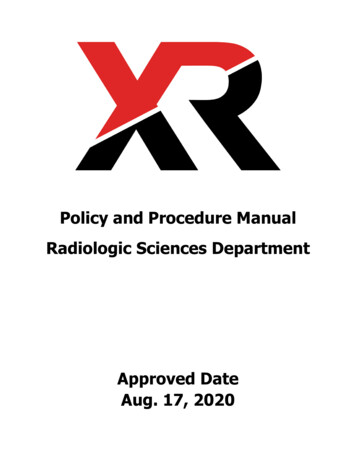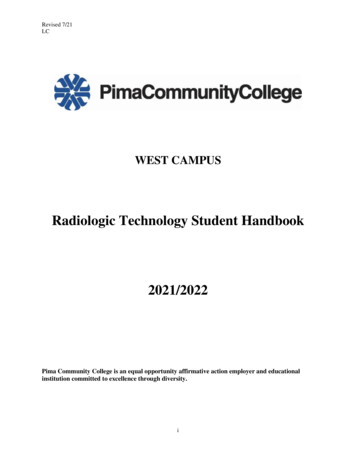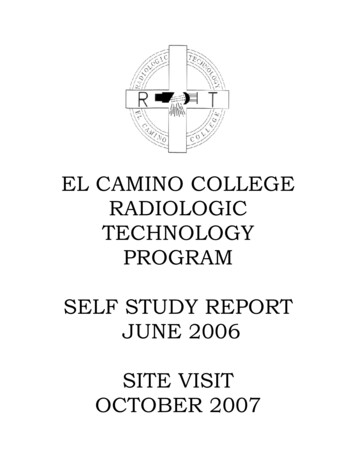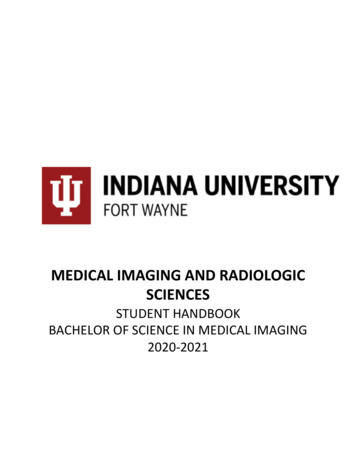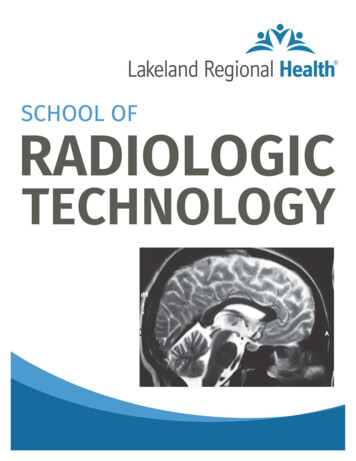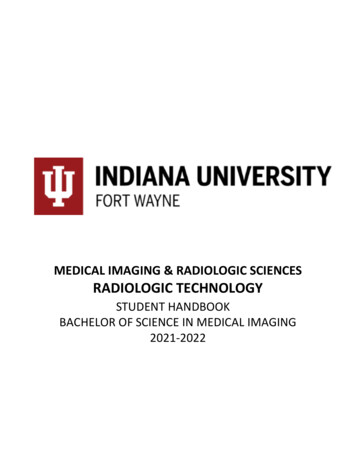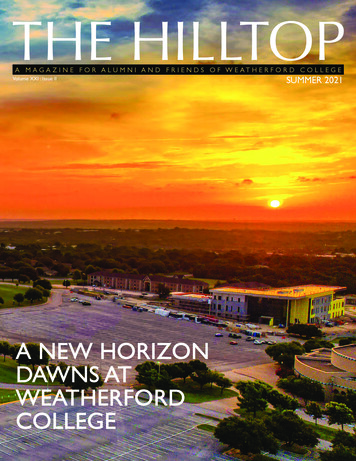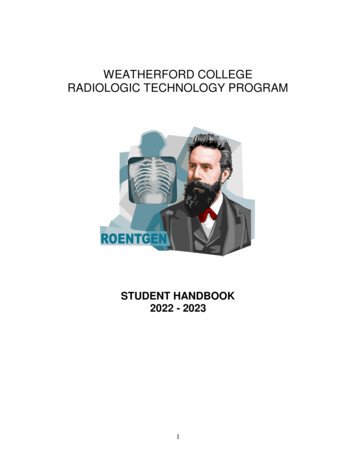
Transcription
WEATHERFORD COLLEGERADIOLOGIC TECHNOLOGY PROGRAMSTUDENT HANDBOOK2022 - 20231
WELCOMEThe administration, faculty, and fellow students of Weatherford College are happy to extend a warm welcome to eachnew student in Radiologic Technology.This program student handbook is prepared and offered as a guide to introduce you to the Radiologic TechnologyProgram, and to present the policies and procedures of the program. The student policies were developed for thepurpose of maintaining an environment conducive to learning as well as student success and patient safety.It is the responsibility of the student to read and abide by the Radiologic Technology policies and to adhere to the rulesand regulations set forth in the Weatherford College general catalog and Student Handbook so that high standards ofeducation may be achieved.We are pleased that you have chosen Weatherford College to assist you in reaching your goal of becoming aRadiologic Technologist.Faculty of the Radiologic Technology ProgramMickey Ryan, Program DirectorPauline Jones, Clinical CoordinatorCrystal Jennings, FacultyWeatherford College is an Equal Opportunity institution that provides educational and employmentopportunities on the basis of merit and without discrimination because of race, color, religion, sex, age,national origin, veteran status, or disability.Weatherford College is accredited by the Southern Association of Colleges and Schools Commission onColleges (SACSCOC) and approved by the Texas Higher Education Coordinating Board. Weatherford CollegeRadiologic Technology Program is accredited by the Joint Review Committee on Education in RadiologicTechnology (JRCERT). JRCERT contact information can be found at: www.jrcert.org.Weatherford College Radiologic Technology Program Accreditation Status: Accredited (per JRCERT Policies10.000 and 10.7000)Length of Accreditation Award: 8-year (awarded in 2017)The Joint Review Committee on Education in Radiologic Technology20 North Wacker Drive, Suite 2850Chicago, Illinois 60606-3182312-704-5300mail@jrcert.orgMission StatementThe Radiologic Technology Program continues the mission of the Health and Human Sciences Division atWeatherford College by offering students a quality education in the radiological sciences.2
TABLE OF CONTENTSProgram Goals and OutcomesProgram EffectivenessASRT Code of EthicsJRCERT Standards PolicyProgram Structure / Application ProcessSelection Process / Graduation Requirements / Transfer ProceduresProgram Dismissal / Reapplication EligibilityAcademic EducationClassroom AttendanceExpected Classroom EtiquetteClassroom Dress CodeCell Phones in the classroomInclement WeatherBereavement PolicyAcademic StandardsWithdrawal from ClassesClinical EducationClinical RequirementsClinical AttendanceClinical Dress CodeClinical DemeritsClinical Competencies and SupervisionStudent AdvisementTransportationFacilities for Clinical EducationCell Phones and Electronic DevicesHarassmentCampus Student ServicesPhysical AbilitiesHealth and Human Sciences Division General ProceduresSocial NetworkPatient IsolationProgram to Program TransferProgram Alcohol/Substance Testing ProcedureLeave of Absence PolicyReligious Holy DaysIncident Categories/AppealIncident FormTechnical Program Grievances/ Appeal ProcedureStudent Grievance Due ProcessProgram Safety Policies & Procedures, Sections I-VMedical Safety, Sections I & IIAppendix IAppendix IIAppendix IIIAppendix IVProgram CurriculumARRT Clinical Competency RequirementsClinical Education Site AffiliationsJRCERT Mammography PolicyStudent Agreement 819202021222324262730303335364243443
Weatherford CollegeRADIOLOGIC TECHNOLOGY PROGRAMWelcome to Weatherford College Radiologic Technology program. The purpose of this handbook is to communicatethe program policies & procedures, student responsibilities, and conditions of training. All information in this manual isreviewed annually, and revised as required.ETHICS, CODE OF CONDUCT, POLICIES & PROCEDURESStudents accepted into the Radiologic Technology program will be expected to adhere to the program Code ofConduct, clinical site, Weatherford College and Radiology program policies & procedures, and ARRT/ASRT Code ofEthics. Failure to follow these guidelines may result in dismissal from the program.PROGRAM GOALS / OUTCOMESClinical Competency - Students will have the prerequisite clinical skills to be an entry level radiographer.Desired Outcomes:1. Students will be able to select appropriate technical parameters to produce diagnostic images.2. Students will be able to demonstrate and identify appropriate anatomy in its entirety in proper position on theirimages.3. Students will demonstrate understanding of ALARA and the requirements set by federal and state agencies.4. Students will demonstrate radiation safety with regard for patients, personnel, and self.Problem-solving and Critical Thinking - Students will demonstrate problem-solving and critical thinking skills in theclinical setting.Desired Outcomes:1. Students will be able to analyze finished radiographic images for diagnostic quality.2. Students will demonstrate problem-solving / critical thinking skills as they relate to the ordered exam andpatient condition.Communication - Students will have oral and written communication skills appropriate to their level of education andhealthcare environment.Desired Outcomes:1. Students will demonstrate appropriate communication skills with the patient and co-workers.2. Students will demonstrate effective oral and written language skills.Professionalism - The students will demonstrate knowledge of professional ethics, professionalism, and life-longlearning in the field.PROGRAM EFFECTIVENESSThe program will assure educational effectiveness and graduate competent entry level radiographers.1. Students will successfully complete the program.2. Students will pass the ARRT examination on 1st attempt.3. Students will be satisfied with their education.4. Employers will be satisfied with the graduate’s performance.5. Students will be employed within 6 months post-graduation.4
AMERICAN SOCIETY OF RADIOLOGIC TECHNOLOGISTSCODE OF ETHICS1. The radiologic technologist conducts himself or herself in a professional manner, responds to patient needs andsupports colleagues and associates in providing quality patient care.2. The radiologic technologist acts to advance the principal objective of the profession to provide services to humanitywith full respect for the dignity of mankind.3. The radiologic technologist delivers patient care and service unrestricted by concerns of personal attributes or thenature of the disease or illness, and without discrimination, regardless of sex, race, creed, religion or socioeconomicstatus.4. The radiologic technologist practices technology founded upon theoretical knowledge and concepts, utilizesequipment and accessories consistent with the purpose for which they have been designed, and employs proceduresand techniques appropriately.5. The radiologic technologist assesses situations, exercises care, discretion and judgment, assumes responsibility forprofessional decisions, and acts in the best interest of the patient.6. The radiologic technologist acts as an agent through observation and communication to obtain pertinent informationfor the physician to aid in the diagnosis and treatment management of the patient, and recognizes that interpretationand diagnosis are outside the scope of the practice for the profession.7. The radiologic technologist utilizes equipment and accessories, employs techniques and procedures, performsservices in accordance with an accepted practice and demonstrates expertise in minimizing the radiation exposure tothe patient, self and other members of the health care team.8. The radiologic technologist practices ethical conduct appropriate to the profession and protects the patient’s right toquality radiologic technology care.9. The radiologic technologist respects confidences entrusted in the course of professional practice, respects thepatient’s right to privacy and reveals confidential information only as required by law or to protect the welfare of theindividual or the community.10. The radiologic technologist continually strives to improve knowledge and skills by participating in educational andprofessional activities, sharing knowledge with colleagues and investigating new and innovative aspects ofprofessional practice. One means available to improve knowledge and skills is through professional continuingeducation.The American Society of Radiologic Technologists and The American Registry of Radiologic Technologists5
JOINT REVIEW COMMITTEE ON EDUCATION IN RADIOLOGIC TECHNOLOGY POLICY(JRCERT)20 N. Wacker Drive, Suite 2850Chicago, IL 60606-3182Phone: (312) 704-5300Fax: (312) 704-5304The Weatherford College Radiologic Technology Program is accredited by the JRCERT and hasadopted the Standards for an Accredited Educational Program in Radiologic Sciences. In doing so,Weatherford College strives to offer the radiologic technology students a quality education that isfounded upon professional and ethical values.A copy of the standards to which we are required to adhere and our program effectiveness statistics canbe found on their website. Students may contact the JRCERT (312) 704-5300 or www.jrcert.orgregarding questions concerning JRCERT standards infractions if they feel that the program and/or schoolofficials have been unable to resolve them satisfactorily after following the college grievance process.See Standards for an Accredited Radiography Program ards.pdf-6Adopted April 2020
PROGRAM STRUCTUREThe Radiologic Technology Program is approximately 21 months in duration. A new class of 24students is started each fall semester. Students will attend the program Monday through Fridayattending classroom lecture, laboratory instruction, and hands-on clinical training at hospital sites.Successful graduates will receive Associates in Applied Sciences degree in RadiologicTechnology. In-district students will incur an approximate program expense of 8800.00, includingtuition, books, laboratory fees, clinical requirements, and graduation costs. Contact the financialservices department at WC if you have questions regarding financial aid.First year studentsIn the first fall and spring semesters will be in the classroom Monday, Wednesday, and Friday. Classroom hours areapproximately 8:00 am to 3:00 pm. On Tuesdays and Thursdays, students will be at their assigned clinical site from 7:30am to 4:00 pm.First year students summer session, students will be at their assigned clinical site 4days/week, 7:30 am to 5:30 pm. During the summer semester, students are given the option to experiencea second shift rotation for two weeks. The hours for this are traditionally 12:00 or 1:00 pm. to 9:00 or10:00 pm.Second Year studentsIn the fall, 4th semester, and spring, 5th semester, students will be in the classroom on Tuesday andThursday. Classroom hours are 8:30 am to, 4:00 pm. Second year students will attendclinical on Monday, Wednesday, and Friday, from 7:30 am to 4:00 pm.Students who need to work while attending the program need to schedule their work hours in theevening and/or on weekends. However, the applicant needs to be aware that working full-timeand successfully completing this program are historically mutually exclusive. The applicant needs toallow ample time for deep learning and examination preparation.(See full curriculum under Appendix II)PROGRAM ORGANIZATIONDean of Health and Human SciencesProgram DirectorProgram Clinical CoordinatorFull-time FacultyMultiple Adjunct Faculty Clinical Instructor’sKathryn Boswell, MSRNMickey Ryan, R.T. (R) (MR), BSRS, MHAPauline Jones, R.T. (R), BSRSCrystal Jennings, R.T. (R) (M), BSRTAPPLICATION TO THE PROGRAMStudents who want to apply to the Radiologic Technology Program first need to have completedpre-requisite courses. Completing co-requisites will qualify them for more points.Pre-requisites: Anatomy and Physiology I, College Algebra, Introduction to Psychology, EnglishComposition ICo-requisites: Humanities or Performing Arts (3 credit hour)Bonus or additional Points: Anatomy and Physiology II and a college degree.Applications are accepted from the first business day of February through the first business day of Mayfollowing fall semester. Students may apply as long as all of the courses above will be completed atthe end of the spring semester. The program will need spring semester grades no later than May 31st.Summer courses will not be considered.Students must also meet specific criteria for admission to the college.Application into the program requires:1. Official transcripts – all college courses7
2. Completed Allied Health Application3. Documentation of Hep B immunization or, at minimum, 2nd shot of series.At the close of spring semester, program officials begin going over the applications. Verification of grades and Hep Bimmunization will occur at this time.SELECTION PROCEDUREA point system will be used for selection of accepted candidates and alternates. The points are derived from thegrades received on the 6 courses listed above; A 4pts, B 3pts, C 2pts (grades lower than “C” will not beaccepted). Additionally, applicants will receive extra points for degrees earned while in college; AA or AAS 4pts and BA or BS or Masters degree 6 pts.Students will be ranked by points accumulated. The 40 applications with the highest cumulative points will beselected for an interview. The top 24* applicants will be accepted into the program and the next 10 applicants will beselected as alternates.*Number of applicants is subject to change.Information received after June 1st will not be included in this process. The top 24 scores will be selected plus 10alternate applicants.Applicants will be notified near the end of June. Those who are accepted into the program or as an alternate in theprogram will receive a letter and an orientation packet. Attendance at the program orientation in July is mandatory.At the orientation candidates will be given instructions on the packet. Students may then begin submitting the itemsrequired for the clinical portion of the program.GRADUATION REQUIREMENTSIn order to graduate from Weatherford College with an A.A.S. degree in Radiologic Technology, a student mustsuccessfully complete accepted pre-requisite and co-requisite courses and the radiology program courses. A minimum of51 different radiographic procedures performed competently on patients must have been completed. Any make-upclinical hours will also have to be completed. Additionally, a degree audit must be performed in the last semester prior tograduation.TRANSFERRING INTO THE PROGRAM FROM ANOTHER RADIOLOGIC TECHNOLOGY PROGRAMIf a student from another program requests to transfer into the program, they must send all collegetranscripts, an application to the radiologic technology program and to Weatherford College, alldocumentation of immunizations, and current CPR to the program director. All transfers into theprogram will occur at the start of the semester. Additionally, certain items must be fulfilled beforeadmittance and program completion:A. Courses completed by the transferring student must match in their scope with the Weatherford College program.This decision is made by the Dean of Student Affairs. Additionally, the previous courses must match in sequencewith our program.B. The transferring student must request that their current program director send a letterto us stating that the student is in good standing in their program; academically andprofessionally.C. The transferring student cannot have any professional / ethical counseling on file intheir current program.D. The transferring student must successfully complete an entrance exam consisting ofquestions from courses already completed.E. The transferring student must successfully complete a clinical competency testF. The transferring student must meet program required pre- and co-requisites.G. The transferring student must complete a minimum of 51% of the program in order to receive a degree inRadiologic Technology from the college.8
PROGRAM DISMISSAL/ ELIGIBILITY REQUIREMENTS FOR RE-APPLICATIONA. Students dismissed from Weatherford College Radiologic Technologist Program are eligible to reapply tothe Radiologic Technology program under the following circumstances:1.2.3.4.5.6.The student is in good standing, andThe student has withdrawn from a program while in good standing, andThe student is not on probation for any academic or non-academic issue.The applicant is not currently on probation, for a disciplinary issue.The applicant is not on probation for a behavioral issue in a clinical education class.The applicant has not received a failing grade in the Program for a behavioral issue.9
ACADEMIC EDUCATIONThe Radiologic Technology Program academic calendar follows the published college academiccalendar in the student catalog. Students are not to attend classes or clinical assignments on datesthat the college is closed.CLASSROOM ATTENDANCEA total of 4 absences per course per semester are permissible. Each absence over this amount willresult in a 10% deduction from the total semester score before the final exam. A tardy will berecorded at one minute past the beginning of lecture time. If more than 15 minutes are missed, thestudent will be recorded as absent for that lecture. All extracurricular activities leading to absenceswill be counted as such. It is the responsibility of the student to obtain information presented in classwhen absent. Students are responsible to read and follow course syllabi for specific informationregarding assignments, evaluative methods, and course exams.Final exams must be taken on the scheduled date/time offered by the instructor.PUNCTUALITY- Refer to the Instructor’s course outline/syllabusStudents are expected to attend lectures and laboratory sessions at the scheduled time. Clinical tardiness will beaddressed under the appropriate section. A student will be allowed into class late at the sole discretion of theinstructor. If a student is not present for roll call, it is the student's responsibility to see the instructor after thelecture to change the "absence" to a "tardy". Any unscheduled, daily examination that may be given during thetardy time will be given a grade of "zero" and may not be made up.Students are responsible for arranging to make up any course work missed due to absences for any reason. If astudent is absent for any reason it is the students responsibility to check with the instructor for any assignments orcourse announcements made during the students absence.Cheating: The program’s policy for cheating specifies that one (1) incident of cheating will result in a gradeof zero (0) for that examination and DISMISSAL FROM THE PROGRAMCheating includes but is not limited to:Copying from the test of another studentAllowing another student to copy from your testPossessing materials or objects not authorized by the instructor during the test, including “crib notes”,programmable calculators, open textbooks, notebooks or notes, even if unused.Copying, recording, buying, stealing, transporting or soliciting tests (pre or post testing), test keys, questions,written assignments, or computer programsSeeking aid from or collaborating with another student for aid without permission from the instructor during a testSubstituting for another person, or permitting another to substitute for youAlteration of scantron or any other grade sheets through changing answers or filling in of blank spaces after beinggradedDiscussing the test with a student who has not already taken the testA student dismissed for cheating or plagiarism will not be eligible for re-entry.Plagiarism is defined as: copying someone else’s work and presenting it as one’s own, without the knowledge ofthe original author. All research due must give credit when quotes are used.ATTENDANCE:Regular attendance of classes is strongly associated with academic success.Students are responsible for regular attendance of classes in which they are enrolled.Instructors will maintain student attendance records throughout the semester.Students who will be absent from class due to their participation in a Weatherford College sponsored or approvedactivity are responsible for informing their instructors prior to their absence in the form of a written notificationprepared and signed by an instructional dean.Students are responsible for arranging to make up any course work missed due to absences for any reason.Make-up work due to absences for any other reason than those listed above will be at the instructor’s discretion.10
EXPECTED CLASSROOM ETIQUETTEWeatherford College is committed to promoting a level of classroom etiquette conducive to maximum teaching andlearning. Within this context, the following etiquette is expected:1.2.3.4.5.6.Attend class each time the class meets.Be on time for class and remain for the entire period. You are inconsiderate of your classmates if youarrive late and leave early.Refrain from talking while the teacher is lecturing. Idle chattering and giggling are disruptive to the classand disrespectful to your teacher and classmates.Be attentive and participate in class.Refrain from bringing non-students to class. This includes children, spouses, boyfriend/girlfriend andfriends. Approval of the above to attend your courses must come from the Dean of Allied Health. Therewill be no exceptions.Demerits will be given for unprofessional classroom conduct and includes the list on pages 15 and 16. Astudent that cannot put their cell phone away and is asked a second time will receive demerits. Also seeCell Phones below. Accumulated demerits will lower a student’s grade leading to grade failure which leadsto program dismissal.CLASSROOM DRESS CODEStudents will be expected to wear clean comfortable clothing that is generally acceptable in public.CELL PHONESCell phones will be turned off during all didactic classes. If there is a situation for the student such that he or shemust receive an emergent phone call during class time, the student is to inform the instructor of this situation. If astudent’s cell phone goes off in class the student will be required to silence or turn the phone off unanswered, and10 points will be deducted from the students next test score. If the cell phone goes off during a test, 15 points willbe deducted from the test score. Subsequent events will result in the doubling of this penalty each time. A studentanswering a phone during class will be required to leave class and meet with the instructor prior to attending classagain. A student answering a phone during a test will receive a 0 grade on the test.INCLEMENT WEATHEROccasionally, classes (including clinical) are cancelled due to weather conditions. Students are to monitorradio/television for Weatherford College closure in bad weather. Students will sign up for the Coyote Alertsystem. Faculty will also monitor the situation. Call your Faculty CI if you are in question about your area.BEREAVEMENTThe program allows a total of three (3) days (including clinical days) for bereavement regarding the loss of amember of immediate family; mother, father, child, brother, sister, or grandparent.ACADEMIC STANDARDSDidactic courses – A minimum passing grade of 78% must be maintained on all required academicRadiologic Technology Program (RADR) courses. The passing minimum grade is 78%. Students mustmaintain a “C” or better in all courses to remain in the program. Grades are assigned percentages as thus:A 100 – 91% B 90 – 83% C 82 – 78% D 77 – 74 F 73 – 0In courses that have a laboratory component, a “C” or better must be recorded in the lecture portion.Clinical courses – A minimum passing grade of 78% must be maintained. The clinical (semester) grade willbe based on the clinical evaluations, competencies, and image critiques from technologists and FacultyClinical Instructors. Grades are assigned percentages as thus:A 100 – 91% B 90 – 83% C 82 – 78% D 77 – 74 F 73 – 0Academically at risk students will be notified of academic deficiencies and will be counseled, eitherformally or informally, by the instructor.11
WITHDRAWAL FROM CLASSESStudents should not drop classes. Due to the sequential nature of program courses, a student whowithdraws from a class must withdraw from the program. Re-admittance to the point of withdrawal isnot guaranteed and will only be granted if the student is able to pass a series of tests to determine iftheir knowledge base has remained intact. Additionally, there must be space in the clinical arena toplace the student. Alternatively, the student may apply to enter the program as a new applicant.Students considering withdrawing from a class must discuss this with the program director priorto taking any action.CLINICAL EDUCATIONThe clinical portion of the program is the most valuable aspect to becoming a fully trainedtechnologist who can perform as a competent professional upon hire into a radiology department.The ARRT has set strict guidelines as to the number of procedure competencies a student mustcomplete before they can sit for the National Registry examination.CLINICAL REQUIREMENTSIt is mandatory that all students receiving a program acceptance or alternate letter must attend the programOrientation. After students receive their program letter of acceptance they must begin collecting and submitthe following documentation to Castle Branch.This documentation must be on file 7 days prior to the first day of classes. You must speak to theClinical Coordinator or Program Director if there are any implications for not having completed this bythe deadline. If there is no communication with the CC or Program Director we will considerate to be asign of your not planning to participate in the program. You will receive an official letter stating you areno longer in the Radiologic Technology Program and your spot will be given to an Alternate Candidate.The following are required items: Immunizations for MMR, Varicella - Positive titer or documentation of 2 vaccinesTDap – Documentation of vaccineBody mechanics/strength testing by a licensed physical therapistCriminal background check / fingerprinting (can take up to 8 weeks for results)AHA CPR BLS (must be valid for the duration of the program)Proof of Medical InsuranceThe student will be told dates to have their Flu shot and TB testStudents will be clinically educated and trained in at least 3 different clinical rotation sites that will beassigned by the Clinical Coordinator. The decision of the coordinator is final. Assignments arecarefully made and several items are considered during this process. There are no weekend orthird shift clinical rotation offerings. Beginning in the summer semester, students are offered theexperience of working on second shift, however, this is not mandatory. Assignments are madein advance (the first rotation is the exception). One site in the first fall and spring semesters,one site during the summer semester, and a third site during the second fall and spring semesters.Additionally, students who have met the mandatory requirements for competencies will be allowed toparticipate in 3 other imaging modalities in their last semester. Students are given a basic safety,patient care and equipment orientation of the new department by their clinical instructor, in additionto an orientation provided by the hospital/department staff. Any student that is on any type of programprobation will not be eligible to participate in choosing modality rotations during the last clinical semester.12
CLINICAL ATTENDANCE POLICYFirst year students are allowed 2 clinical rotation absences their first Spring and Fall semesters of theprogram. Summer semester the first year students are allowed 3 clinical rotation absences per semester.Second year students are allowed 3 clinical rotation absences per semester. However, absences are highlydiscouraged. The expectation of the program is that students will not miss any clinical rotation hours.The student must contact BOTH their Clinical Instructor / program faculty prior to any absence ANDcall in to the clinical site and speak to either a supervisor or other designated employee. An absencethat is not communicated to both parties will be considered a no-call, no-show and could lead todismissal from the program. Communication to only one party will result in counseling. Calls after thestart of the shift will be unacceptable. Students may not make up lost time by staying late or coming inearly. All extracurricular activities that lead to absences will be counted as such. Students are tocarefully read the Clinical Syllabi for each semester for all course expectations and requirements.Exception:Special allowances will be made only for court appearances and emergent, non-elective medical events*.Court appearances must be cleared with the clinical instructor no less than 24 hours in advance. Make up timefor these issues may be granted if:The student has no written counseling in their file.The student would fail the program without the make up time.The student has not been granted a previous make up privilege.The make up time does not exceed 16 hours.*If a student tests positive for COVID-19, those absences will not be counted towards their clinical rotationabsences for that semester. Weatherford College will follow the current CDC guidelines. Make-up time will bediscussed with the program faculty and will be handled on a case-by-case basis.Tardiness: Clinical – Students are to arrive on time, ready to work, in full compliance with the program dresscode. A "T" (tardy) will be recorded at 0731. Six "T"'s will be charged as 1 absence. A loss of 15 minutes,for any reason at
The Weatherford College Radiologic Technology Program is accredited by the JRCERT and has adopted the Standards for an Accredited Educational Program in Radiologic Sciences. In doing so, Weatherford College strives to offer the radiologic technology students a quality education that is founded upon professional and ethical values.
